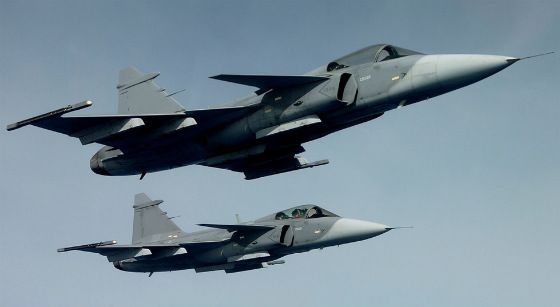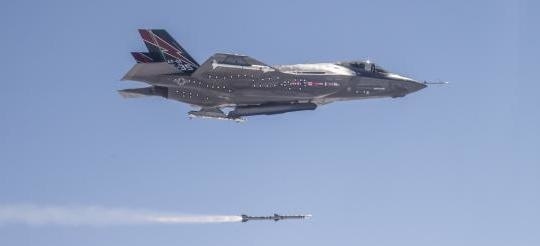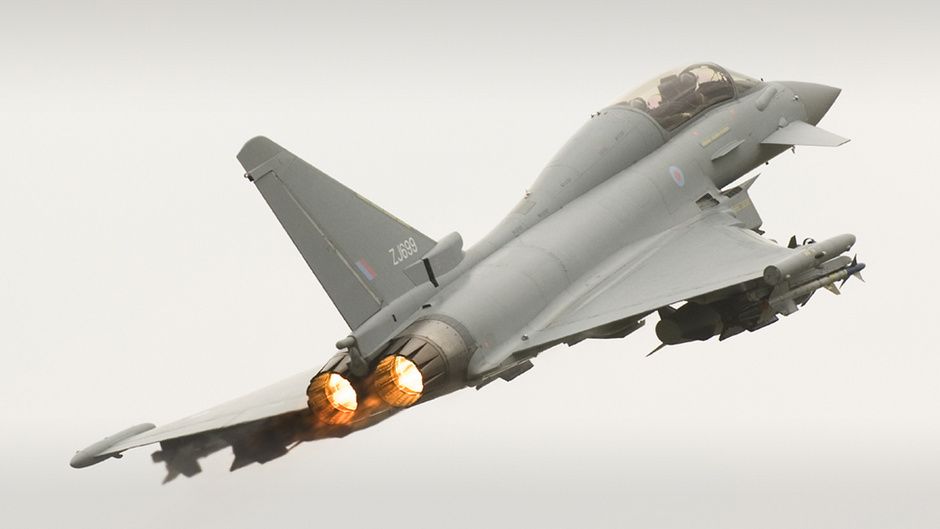The F-35 Flies Amid Europe’s Mature Aeronautics Market
Posted on
The F-35 Lightning II European debut in July will be welcome, but it remains the Punch and Judy program of the defense aerospace sector, with boosters and detractors taking turns to bash each other’s argument as to the project’s value — or lack thereof.
The debate, though sometime not worthy of the word, has risked becoming so polarized that neither camp is capable of recognizing nor admitting to any virtue in the others argument. This is a pity because, as is so often the case, any kind of ground truth lies somewhere betwixt and between.
The aircraft is indubitably and considerably late and over-cost, which is about par for the course for a combat aircraft development. The fundamental question is whether its performance will be worth the wait and the sticker price. Hyperbole aside, the program is the Pentagon’s most expensive, and the most important weapon system for the Air Force and Marine Corps, if less so for the Navy. The F-35 is also at the heart of numerous other air forces’ future road maps. Bundle these together and an uncomfortable question arises — if not the F-35, then what? Further developments of fourth-generation platforms will get you some, but not all of the way in terms of capability, and at a cost — and a reduced signature platform will still be required by many if not all of the present customers. The American Air Force is relying on an increasingly aged tactical fighter aircraft fleet, with the associated support and logistics demands and costs.
These domestic and structural concerns are now being compounded by an uncomfortable deterioration in relations with an erstwhile strategic rival, Russia, that has its own fifth-generation combat aircraft in development, as well as a range of advanced air defense systems either being fielded or in the pipeline.
But if the rhetoric between Russia, its neighbors and the United States may be redolent of the Cold War it is well worth keeping in mind MarkTwain’s aphorism that history rhymes rather than repeats. Irrespective of Moscow’s acts against Ukraine Europe has not been plunged back in to super-power confrontation, Crimea is unlikely to prove this generation’s Berlin Airlift.
Of the two former bloc-leaders, one is no longer a superpower, while the other’s locus of strategic interest is not Europe but the Asia-Pacific, and will remain so. This, however, does not mean Moscow’s behavior will have a transient effect on the continent. At the least it is a sharp reminder that European security cannot be taken for granted when it comes to state actors behavior, and Moscow’s annexation of Crimea also raises uncomfortable questions about how much and how European nations spend on defense.
US National Security Advisor Susan Rice’s recent admonition that Europe must increase its defense budgets is one of those long-term US pastimes akin somewhat to barking at the Moon. Anything beyond holding the line on present levels of defense expenditure — and perhaps vague ambitions to reverse slowly the downward trend over time — that emerges from the September NATO summit in the UK would be notable – the European target of 2 percent of GDP defense spending appears now as much of an albatross as a goal. Budget pressures have already resulted in some European customers trimming the number of F-35s they plan to buy, while others have remained noncommittal as to the eventual number they will buy.
Some of this is driven by the fact that the European economic recovery remains patchy and faltering. It remains the overriding concern of the public, rather than Russian military adventurism in the Ukraine. In the near term any military intervention or increased defense spending will prove a very hard sell to a skeptical public. Of course, the court of popular opinion is fickle and today’ s and tomorrow’s reticence may well fade.
For the European defense aerospace sector the reality of continuing pressure on defense spending, rather than transatlantic exhortations to reverse a two-decade plus trend, will continue to drive strategy in what remains a difficult environment.
There is little to no opportunity for organic growth in domestic or European marketplaces, while expansion by acquisition – at least at the prime level – could court political intervention. Meanwhile, the international arena is ever more crowded and competitive as new entrants jostle for elbow room with existing players keen to offset domestic reductions with increased external sales. As traditional export markets mature there are greater political demands for technology access among purchasing countries and for investment to support local industry, rather than buying simply off-the-shelf. Technology access has already proved problematic for some European F-35 customers.
For the West in general, and the USA in particular, the pressure to provide greater technology access is in parallel to the erosion in some areas of traditional technological superiority over possible adversaries. The assumption that any numerical inferiority could be trumped easily by more capable systems will likely not be a given in future.
For the Europeans these challenges are compounded by concern about how long the combat aircraft platforms will be in production. By the middle of the next decade it is quite conceivable that Europe will not have a crewed combat aircraft either in production or development. Unmanned or remotely piloted air systems will go some way to replacing the present production capacity, but by no means all, and it is difficult to see anything other than a reduction in the design and manufacturing footprint. German Chancellor Angela Merkel’s success in blocking the then EADS ‘merger’ with BAE Systems raises the risks of a strategic defeat for the European defense aerospace sector.
 Of Europe’s three mature combat aircraft designs, Sweden’s Saab Gripen is arguably the best placed. Assuming its selection in Brazil results in a contract, then it will have an export launch customer for the Gripen E/F development along with a domestic order from the Swedish Air Force. While the outcome of the Swiss referendum rejecting the Gripen E was a disappointment, the Brazilian selection provided Saab with a cushion for the blow.
Of Europe’s three mature combat aircraft designs, Sweden’s Saab Gripen is arguably the best placed. Assuming its selection in Brazil results in a contract, then it will have an export launch customer for the Gripen E/F development along with a domestic order from the Swedish Air Force. While the outcome of the Swiss referendum rejecting the Gripen E was a disappointment, the Brazilian selection provided Saab with a cushion for the blow.
The mid-life refresh of the Gripen, along with an attractive price point, could see it garner further sales in countries looking to replace third-generation or early fourth-generation platforms with a more capable type where they cannot afford or have no interest in a larger combat aircraft, or — indeed — the F-35.
The four-nation Eurofighter Typhoon could end production as early as 2018 unless more orders are secured. There remains a potential follow-on purchase from Saudi Arabia with upward of 48 aircraft mooted as a second batch to complement the 72 already being delivered. A number of other opportunities are also being pursued. Of the Typhoon’s partner companies, BAE Systems has the cushion of the manufacture of the rear section of the F-35.
Meanwhile, at press time France’s Dassault has yet to sign the contract on a 126-aircraft order for the Rafale, two years after the type was selected by the Indian Air Force to meet its Medium Multi-role Combat Aircraft requirement. The French aircraft was also widely tipped to garner part of any order from Qatar for up to 72 aircraft.
Irrespective of the outcome of the aforementioned competitions production of all three European platforms will almost certainly have ended during the next decade. That raises many questions for the European defense aerospace sector. It will also be during the course of the next decade that several European air forces will discover if their investment in and patience with the F-35 has been justified fully or otherwise.
Douglas Barrie is the senior fellow for military aerospace at London’s respected International Institute for Strategic Studies. He successfully practiced writing while European editor of Defense News when I was the editor.
Subscribe to our newsletter
Promotions, new products and sales. Directly to your inbox.



